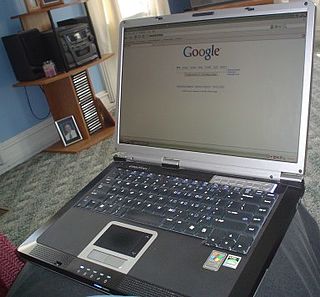Related Research Articles

In computing, a device driver is a computer program that operates or controls a particular type of device that is attached to a computer or automaton. A driver provides a software interface to hardware devices, enabling operating systems and other computer programs to access hardware functions without needing to know precise details about the hardware being used.
Direct memory access (DMA) is a feature of computer systems that allows certain hardware subsystems to access main system memory independently of the central processing unit (CPU).
In computing, a plug and play (PnP) device or computer bus is one with a specification that facilitates the recognition of a hardware component in a system without the need for physical device configuration or user intervention in resolving resource conflicts. The term "plug and play" has since been expanded to a wide variety of applications to which the same lack of user setup applies.
A rootkit is a collection of computer software, typically malicious, designed to enable access to a computer or an area of its software that is not otherwise allowed and often masks its existence or the existence of other software. The term rootkit is a compound of "root" and the word "kit". The term "rootkit" has negative connotations through its association with malware.
Memory-mapped I/O (MMIO) and port-mapped I/O (PMIO) are two complementary methods of performing input/output (I/O) between the central processing unit (CPU) and peripheral devices in a computer. An alternative approach is using dedicated I/O processors, commonly known as channels on mainframe computers, which execute their own instructions.
A host controller interface (HCI) is a register-level interface that enables a host controller for USB or IEEE 1394 hardware to communicate with a host controller driver in software. The driver software is typically provided with an operating system of a personal computer, but may also be implemented by application-specific devices such as a microcontroller.
PCI configuration space is the underlying way that the Conventional PCI, PCI-X and PCI Express perform auto configuration of the cards inserted into their bus.
lspci is a command on Unix-like operating systems that prints ("lists") detailed information about all PCI buses and devices in the system. It is based on a common portable library libpci which offers access to the PCI configuration space on a variety of operating systems.

In computing, an input–output memory management unit (IOMMU) is a memory management unit (MMU) connecting a direct-memory-access–capable (DMA-capable) I/O bus to the main memory. Like a traditional MMU, which translates CPU-visible virtual addresses to physical addresses, the IOMMU maps device-visible virtual addresses to physical addresses. Some units also provide memory protection from faulty or malicious devices.
The graphics address remapping table (GART), also known as the graphics aperture remapping table, or graphics translation table (GTT), is an I/O memory management unit (IOMMU) used by Accelerated Graphics Port (AGP) and PCI Express (PCIe) graphics cards. The GART allows the graphics card direct memory access (DMA) to the host system memory, through which buffers of textures, polygon meshes and other data are loaded. AMD later reused the same mechanism for I/O virtualization with other peripherals including disk controllers and network adapters.
Thunderbolt is the brand name of a hardware interface for the connection of external peripherals to a computer. It was developed by Intel in collaboration with Apple. It was initially marketed under the name Light Peak, and first sold as part of an end-user product on 24 February 2011.

IEEE 1394 is an interface standard for a serial bus for high-speed communications and isochronous real-time data transfer. It was developed in the late 1980s and early 1990s by Apple in cooperation with a number of companies, primarily Sony and Panasonic. It is most commonly known by the name FireWire (Apple), though other brand names exist such as i.LINK (Sony), and Lynx.
Nvidia Optimus is a computer GPU switching technology created by Nvidia which, depending on the resource load generated by client software applications, will seamlessly switch between two graphics adapters within a computer system in order to provide either maximum performance or minimum power draw from the system's graphics rendering hardware.
In computing, the term 3 GB barrier refers to a limitation of some 32-bit operating systems running on x86 microprocessors. It prevents the operating systems from using all of 4 GiB (4 × 10243 bytes) of main memory. The exact barrier varies by motherboard and I/O device configuration, particularly the size of video RAM; it may be in the range of 2.75 GB to 3.5 GB. The barrier is not present with a 64-bit processor and 64-bit operating system, or with certain x86 hardware and an operating system such as Linux or certain versions of Windows Server and macOS that allow use of Physical Address Extension (PAE) mode on x86 to access more than 4 GiB of RAM.

In computing, Linux-IO (LIO) Target is an open-source implementation of the SCSI target that has become the standard one included in the Linux kernel. Internally, LIO does not initiate sessions, but instead provides one or more Logical Unit Numbers (LUNs), waits for SCSI commands from a SCSI initiator, and performs required input/output data transfers. LIO supports common storage fabrics, including FCoE, Fibre Channel, IEEE 1394, iSCSI, iSCSI Extensions for RDMA (iSER), SCSI RDMA Protocol (SRP) and USB. It is included in most Linux distributions; native support for LIO in QEMU/KVM, libvirt, and OpenStack makes LIO also a storage option for cloud deployments.

The AMD 900 chipset series is identical to the AMD 800 chipset series except for the fact that it is only found on Socket AM3+ mainboards, whereas its predecessor is only found on Socket AM3 mainboards. It was released in 2011.

Meltdown is one of the two original transient execution CPU vulnerabilities. Meltdown affects Intel x86 microprocessors, IBM POWER processors, and some ARM-based microprocessors. It allows a rogue process to read all memory, even when it is not authorized to do so.

An evil maid attack is an attack on an unattended device, in which an attacker with physical access alters it in some undetectable way so that they can later access the device, or the data on it.
SWAPGS, also known as Spectre variant 1, is a computer security vulnerability that utilizes the branch prediction used in modern microprocessors. Most processors use a form of speculative execution, this feature allows the processors to make educated guesses about the instructions that will most likely need to be executed in the near future. This speculation can leave traces in the cache, which attackers use to extract data using a timing attack, similar to side-channel exploitation of Spectre.
Thunderspy is a type of security vulnerability, based on the Intel Thunderbolt 3 port, first reported publicly on 10 May 2020, that can result in an evil maid attack gaining full access to a computer's information in about five minutes, and may affect millions of Apple, Linux and Windows computers, as well as any computers manufactured before 2019, and some after that.
References
- ↑ Freddie Witherden (2010-09-07). "Memory Forensics Over the IEEE 1394 Interface" (PDF). Retrieved 2024-05-22.
- ↑ Piegdon, David Rasmus (2006-02-21). Hacking in Physically Addressable Memory - A Proof of Concept (PDF). Seminar of Advanced Exploitation Techniques, WS 2006/2007.
- ↑ "Blocking the SBP-2 Driver to Reduce 1394 DMA Threats to BitLocker". Microsoft. 2011-03-04. Retrieved 2011-03-15.
- ↑ Tom Green. "1394 Kernel Debugging: Tips And Tricks". Microsoft. Archived from the original on 2011-04-09. Retrieved 2011-04-02.
- ↑ "Inception is a physical memory manipulation and hacking tool exploiting PCI-based DMA. The tool can attack over FireWire, Thunderbolt, ExpressCard, PC Card and any other PCI/PCIe interfaces.: carm." 28 June 2019 – via GitHub.
- ↑ "/linux/Documentation/Intel-IOMMU.txt". 14 July 2014. Archived from the original on 14 July 2014.
- ↑ "Linux Kernel Driver DataBase: CONFIG_AMD_IOMMU: AMD IOMMU support". cateee.net.
- ↑ Dansimp. "Kernel DMA Protection (Windows 10) - Microsoft 365 Security". docs.microsoft.com. Retrieved 2021-02-16.
- ↑ Hermann, Uwe (14 August 2008). "Physical memory attacks via FireWire/DMA - Part 1: Overview and Mitigation". Archived from the original on 4 March 2016.
- ↑ "Countermeasures: Protecting BitLocker-encrypted Devices from Attacks". Microsoft. January 2014. Archived from the original on 2014-03-24.
- ↑ "Thunderclap: Exploring Vulnerabilities in Operating System IOMMU Protection via DMA from Untrustworthy Peripherals – NDSS Symposium" . Retrieved 2020-01-21.
- ↑ Blass, Erik-Oliver (2012). "Tresor-Hunt". Proceedings of the 28th Annual Computer Security Applications Conference. pp. 71–78. doi:10.1145/2420950.2420961. ISBN 9781450313124. S2CID 739758.
- ↑ "KB2516445: Blocking the SBP-2 Driver to Reduce 1394 DMA Threats to Bitlocker". Microsoft. 2011-03-04. Retrieved 2011-03-15.